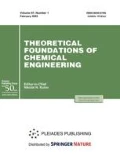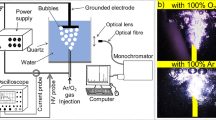Abstract
The study continues research into the dispersion of metals in pulsed discharges in nitric and sulfuric acid solutions. It was revealed that metal powders are the main product that forms in the dispersion of tungsten, titanium, molybdenum. It was found that the current pulse frequency fed to the electrodes significantly effects the productivity of the process. Thermodynamic calculations show that the atomic oxygen produced in the process oxidizes dispersed metal particles, and a film containing stable forms of metal oxides forms on their surfaces. Our results confirm the earlier stated assumptions: atomic oxygen is formed as the working solution undergoes thermal decomposition in the spark discharge zone, and it participates in oxidation of dispersed metal particles, forming a protective oxide film on the surface, which protects the metal from interacting with the environment.

Similar content being viewed by others
REFERENCES
Libenson, G.A., Lopatin, V.Yu., and Komarnitskii, G.V., Processes of Powder Metallurgy, vol. 1: Production of Metal Powders, Moscow: MISIS, 2001.
Vorob’eva, M.V., Edrennikova, E.E., Ivanov V.V., et al., A method to produce a tungsten powder, RF Patent 2448809. Published April 27, 2012.
Kalmykova, L.P., Dovzhenko, N.N., Kovtun O.P., et al., A method to produce a tungsten powder, RF Patent 2362654. Published July 27, 2012.
Silva da, G.G., Alves, C., Hajek, V., et al., Production of tungsten powder by plasma reduction of WO3: Structure and morphology, Int. J. Powder Metall., 2005, vol. 41, no. 4, pp. 43–50.
Gürmen, S., Orhan, G., and Timur, S., Tungsten powder production from scheelite concentrates, Metall, 2003, vol. 57, no. 12, pp. 789–793.
Gostishchev, V.V., Physicochemical aspects of production of a tungsten powder by metallothermy of scheelite concentrate in ionic melts, Izv. Vyssh. Uchebn. Zaved., Tsvetn. Metall., 2015, no. 3, pp. 22–24.
Vorob’eva, M.V., Edrennikova, E.V., Ivanov, V.V., et al., A method to produce nanodispersed molybdenum powders, RF Patent 2367543. Published September 20, 2009.
Rakova, N.N., Edrennikova, E.E., Vorob`eva, M.V., et al., Production of high purity microcrystalline molybdenum and rhenium powders by reduction in hydrogen–nitrogen media, 2011, vol. 52, no. 6, pp. 532–537. https://doi.org/10.3103/S1067821211060113
Gostishev, V.V., Khosen, R.I., Khimukhin, S.N., et al., Obtaining molybdenum powder metallothermy of its compounds in sodium chloride melt, Russ. J. Non-Ferrous Met., 2010, vol. 51, no. 6, pp. 490–493. https://doi.org/10.3103/S1067821210060106
Gostishchev, V.V. and Boiko, V.F., Production of Molybdenum and Tungsten Powders, Khim. Tekhnol., 2006, no. 8, pp. 15–17.
Karelin, V.A. and Kovalev, S.V., Synthesis of a high-purity molybdenum powder by an electrolytical method from fluoride melts, Izv. Tomsk. Politekh. Univ., 2005, vol. 308, no. 3, pp. 97–100.
Sorokina, E.A. and Karelin, V.A., Using fluoride melts for producing titanium from fluoride melts, Usp. Sovrem. Estestvozn., 2014, no. 8, pp. 82–87.
McCracken, C.G., Motchenbacher, C., and Barbis, D.P., Review of titanium powder production methods, Int. J. Powder Metall., 2010, vol. 46, no. 5, pp. 19–26.
Bairamov, R.K. and Somova, Yu.Yu., Mechanism of electric spark dispersion of aluminum in aqueous solutions, Russ. J. Inorg. Chem., 2014, vol. 5, no. 4, pp. 368–372. https://doi.org/10.1134/S0036023614040020
Bairamov, R.K., Vedernikova, N.R., and Ermakov, A.I., Spark dispersion of aluminum and its subsequent hydration, Russ. J. Appl. Chem., 2001, vol. 74, no. 10, pp. 1756–1758.
Ishibashi, W., Araki, N., Kishimoto, K., et al., Method of producing pure alumina by spark discharge process at the characteristics thereof, Ceram. Jpn., 1971, vol. 6, pp. 461–463.
Ishibashi, W., The reaction between powder and liquid medium at spark discharge point, J. Jpn. Soc. Powder Powder Metall., 1977, vol. 24, pp. 113–117. https://doi.org/10.2497/JJSPM.24.113
Bairamov, R.K., Sabanin, A.V., Gorozhankin, E.V., et al., USSR Patent 919278, A method to produce pseudoboehmite aluminum hydroxide. Published December 7, 1981.
Tsoi, A.D., Petrenko, B.Ya., Asanov, U.A., et al., USSR Patent 592753, A method to produce aluminum hydroxide. Published February 15, 1978.
Bairamov, R.K., USSR Patent 1548950, A method to produce aluminum powder. Published November 8, 1989.
Magnitsskii, Ya.Yu., Kozyaruk O.I., and Zhuravel’, S.N., RF Patent 2255837, A device for electric spark dispersion of metals. Published October 7, 2005.
Tarasov, V.I., Kozyaruk, O.I., and Fominskii, L.P., RF Patent 2200589, A device for electric spark dispersion of metals. Published November 15, 1993.
Milyakh, A.N., Shcherba, A.A., Muratov, V.A., et al., USSR Patent 1197066, A pulse generator for electric spark dispersion of conducting materials. Published July 12, 1985.
The Chemist’s Handbook, Moscow: Gos. Nauch.-Tekh. Izd. Khim. Lit., 1982, vol. 1.
Concise Handbook of Physicochemical Quantities, Ravdel’, A.A. and Ponomareva, A.M., Eds., Leningrad: Khimiya, 1983.
Bairamov, R.K. and Bugrov, A.V., Thermodynamic probability of possible reactions in a spark discharge zone, Tsvetn. Metall., 2009, no. 12, pp. 87–90.
Funding
The study was carried out within the state task of the Institute of General and Inorganic Chemistry in the field of fundamental scientific research.
Author information
Authors and Affiliations
Corresponding author
Ethics declarations
The authors declare that they have no conflicts of interest.
Rights and permissions
About this article
Cite this article
Bairamov, R.K., Grigoriev, M.Y., Panasyuk, G.P. et al. Obtaining Tungsten, Titanium, and Molybdenum Powders during their Dispersion in Pulsed Discharges in Aqueous Solutions. Theor Found Chem Eng 56, 296–300 (2022). https://doi.org/10.1134/S0040579522030046
Received:
Revised:
Accepted:
Published:
Issue Date:
DOI: https://doi.org/10.1134/S0040579522030046




